INFS 5057: UniSA - Project Plan for Bulla Dairy Foods ERP System
VerifiedAdded on 2023/06/11
|17
|3415
|351
Report
AI Summary
This document presents a comprehensive project plan for implementing an ERP system at Bulla Dairy Foods, developed within the context of the INFS 5057: Project Management for IT Professionals course at the University of South Australia. The plan outlines the project's background, objectives, desired outcomes, scope, constraints, and assumptions. It details the project approach, recommending a phased review process to ensure alignment with Bulla Dairy Foods' needs. A business case is presented, highlighting expected benefits such as enhanced business operations, improved customer behavior prediction, and better inventory management, alongside potential dis-benefits like high implementation costs and reliance on a cloud vendor. The plan includes a project management team structure, role descriptions, and strategies for quality management, configuration management, risk management, and communication. It also provides a detailed project schedule, cost breakdown, and outlines project controls for monitoring and ensuring successful implementation.
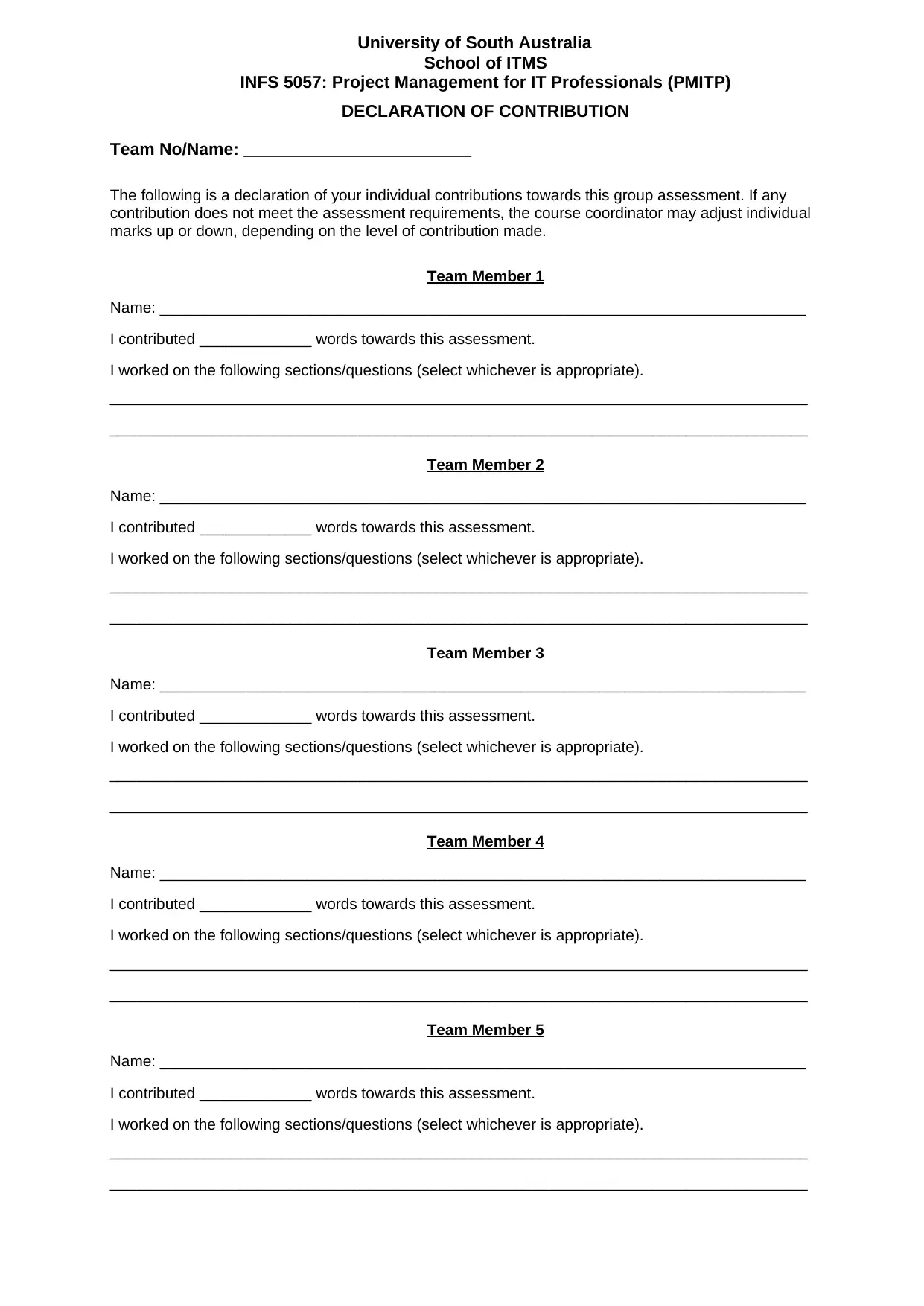
University of South Australia
School of ITMS
INFS 5057: Project Management for IT Professionals (PMITP)
DECLARATION OF CONTRIBUTION
Team No/Name: ________________________
The following is a declaration of your individual contributions towards this group assessment. If any
contribution does not meet the assessment requirements, the course coordinator may adjust individual
marks up or down, depending on the level of contribution made.
Team Member 1
Name: ___________________________________________________________________________
I contributed _____________ words towards this assessment.
I worked on the following sections/questions (select whichever is appropriate).
_________________________________________________________________________________
_________________________________________________________________________________
Team Member 2
Name: ___________________________________________________________________________
I contributed _____________ words towards this assessment.
I worked on the following sections/questions (select whichever is appropriate).
_________________________________________________________________________________
_________________________________________________________________________________
Team Member 3
Name: ___________________________________________________________________________
I contributed _____________ words towards this assessment.
I worked on the following sections/questions (select whichever is appropriate).
_________________________________________________________________________________
_________________________________________________________________________________
Team Member 4
Name: ___________________________________________________________________________
I contributed _____________ words towards this assessment.
I worked on the following sections/questions (select whichever is appropriate).
_________________________________________________________________________________
_________________________________________________________________________________
Team Member 5
Name: ___________________________________________________________________________
I contributed _____________ words towards this assessment.
I worked on the following sections/questions (select whichever is appropriate).
_________________________________________________________________________________
_________________________________________________________________________________
School of ITMS
INFS 5057: Project Management for IT Professionals (PMITP)
DECLARATION OF CONTRIBUTION
Team No/Name: ________________________
The following is a declaration of your individual contributions towards this group assessment. If any
contribution does not meet the assessment requirements, the course coordinator may adjust individual
marks up or down, depending on the level of contribution made.
Team Member 1
Name: ___________________________________________________________________________
I contributed _____________ words towards this assessment.
I worked on the following sections/questions (select whichever is appropriate).
_________________________________________________________________________________
_________________________________________________________________________________
Team Member 2
Name: ___________________________________________________________________________
I contributed _____________ words towards this assessment.
I worked on the following sections/questions (select whichever is appropriate).
_________________________________________________________________________________
_________________________________________________________________________________
Team Member 3
Name: ___________________________________________________________________________
I contributed _____________ words towards this assessment.
I worked on the following sections/questions (select whichever is appropriate).
_________________________________________________________________________________
_________________________________________________________________________________
Team Member 4
Name: ___________________________________________________________________________
I contributed _____________ words towards this assessment.
I worked on the following sections/questions (select whichever is appropriate).
_________________________________________________________________________________
_________________________________________________________________________________
Team Member 5
Name: ___________________________________________________________________________
I contributed _____________ words towards this assessment.
I worked on the following sections/questions (select whichever is appropriate).
_________________________________________________________________________________
_________________________________________________________________________________
Secure Best Marks with AI Grader
Need help grading? Try our AI Grader for instant feedback on your assignments.
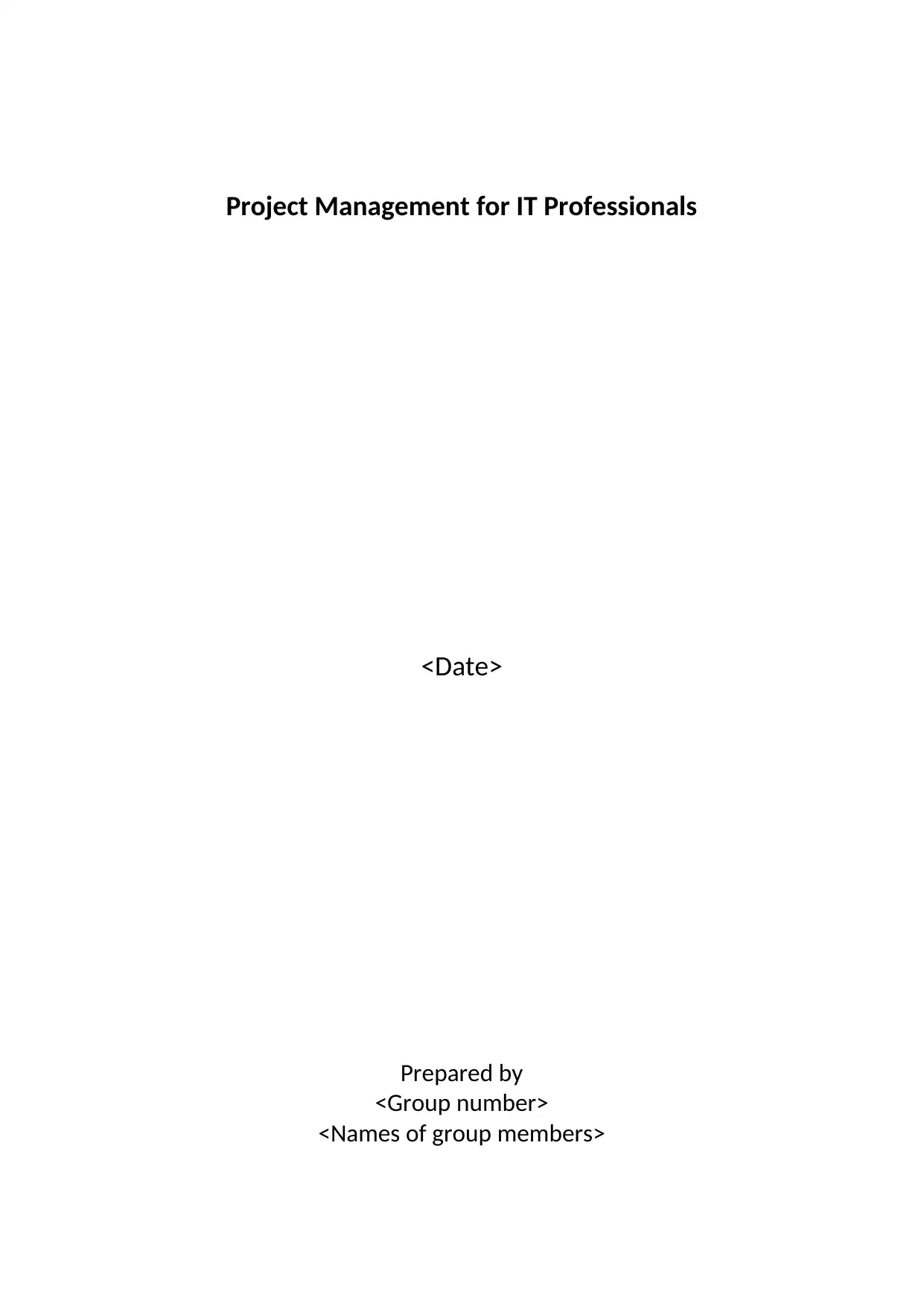
Project Management for IT Professionals
<Date>
Prepared by
<Group number>
<Names of group members>
<Date>
Prepared by
<Group number>
<Names of group members>
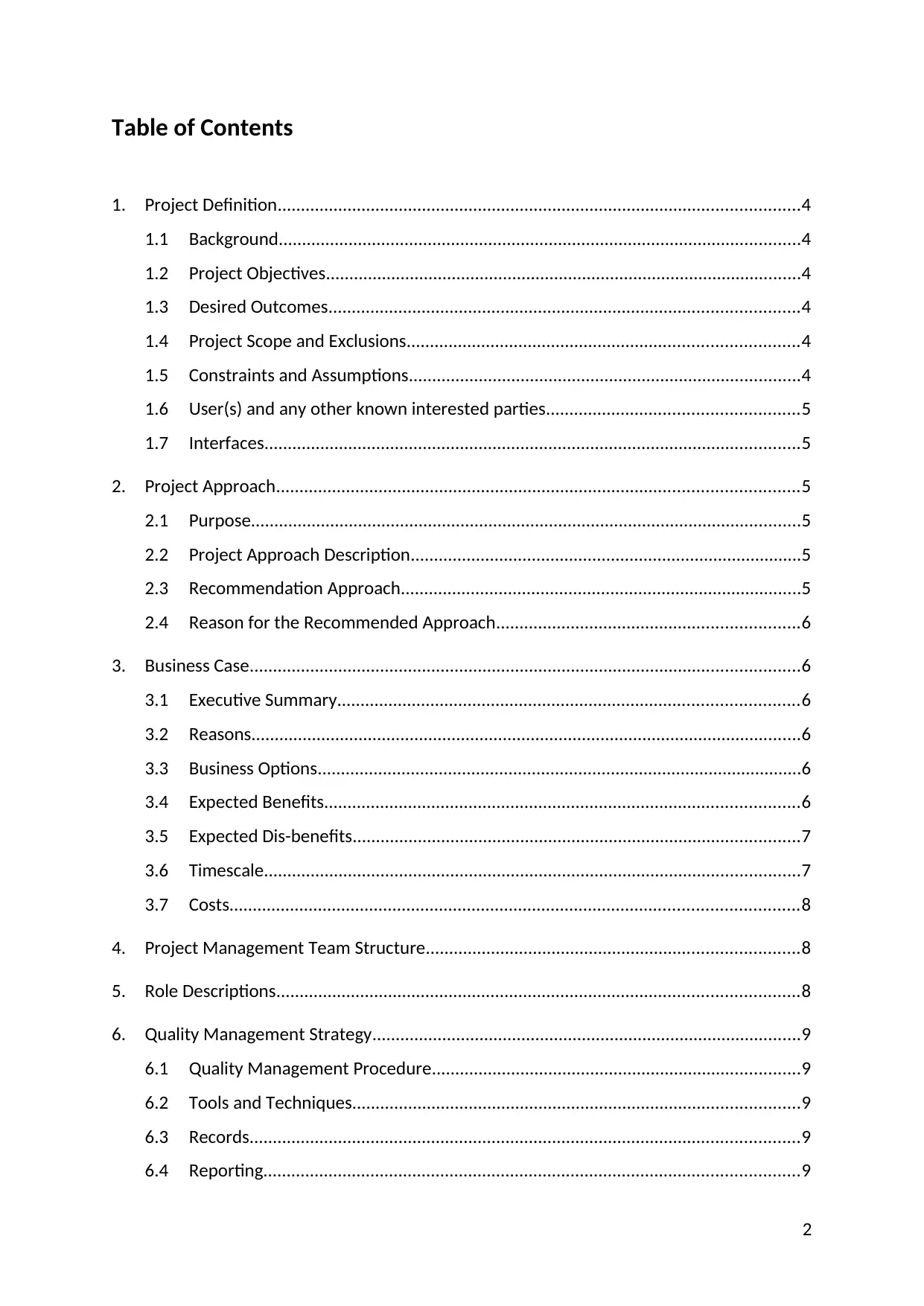
Table of Contents
1. Project Definition................................................................................................................4
1.1 Background................................................................................................................4
1.2 Project Objectives......................................................................................................4
1.3 Desired Outcomes.....................................................................................................4
1.4 Project Scope and Exclusions....................................................................................4
1.5 Constraints and Assumptions....................................................................................4
1.6 User(s) and any other known interested parties......................................................5
1.7 Interfaces...................................................................................................................5
2. Project Approach................................................................................................................5
2.1 Purpose......................................................................................................................5
2.2 Project Approach Description....................................................................................5
2.3 Recommendation Approach......................................................................................5
2.4 Reason for the Recommended Approach.................................................................6
3. Business Case......................................................................................................................6
3.1 Executive Summary...................................................................................................6
3.2 Reasons......................................................................................................................6
3.3 Business Options........................................................................................................6
3.4 Expected Benefits......................................................................................................6
3.5 Expected Dis-benefits................................................................................................7
3.6 Timescale...................................................................................................................7
3.7 Costs..........................................................................................................................8
4. Project Management Team Structure................................................................................8
5. Role Descriptions................................................................................................................8
6. Quality Management Strategy............................................................................................9
6.1 Quality Management Procedure...............................................................................9
6.2 Tools and Techniques................................................................................................9
6.3 Records......................................................................................................................9
6.4 Reporting...................................................................................................................9
2
1. Project Definition................................................................................................................4
1.1 Background................................................................................................................4
1.2 Project Objectives......................................................................................................4
1.3 Desired Outcomes.....................................................................................................4
1.4 Project Scope and Exclusions....................................................................................4
1.5 Constraints and Assumptions....................................................................................4
1.6 User(s) and any other known interested parties......................................................5
1.7 Interfaces...................................................................................................................5
2. Project Approach................................................................................................................5
2.1 Purpose......................................................................................................................5
2.2 Project Approach Description....................................................................................5
2.3 Recommendation Approach......................................................................................5
2.4 Reason for the Recommended Approach.................................................................6
3. Business Case......................................................................................................................6
3.1 Executive Summary...................................................................................................6
3.2 Reasons......................................................................................................................6
3.3 Business Options........................................................................................................6
3.4 Expected Benefits......................................................................................................6
3.5 Expected Dis-benefits................................................................................................7
3.6 Timescale...................................................................................................................7
3.7 Costs..........................................................................................................................8
4. Project Management Team Structure................................................................................8
5. Role Descriptions................................................................................................................8
6. Quality Management Strategy............................................................................................9
6.1 Quality Management Procedure...............................................................................9
6.2 Tools and Techniques................................................................................................9
6.3 Records......................................................................................................................9
6.4 Reporting...................................................................................................................9
2
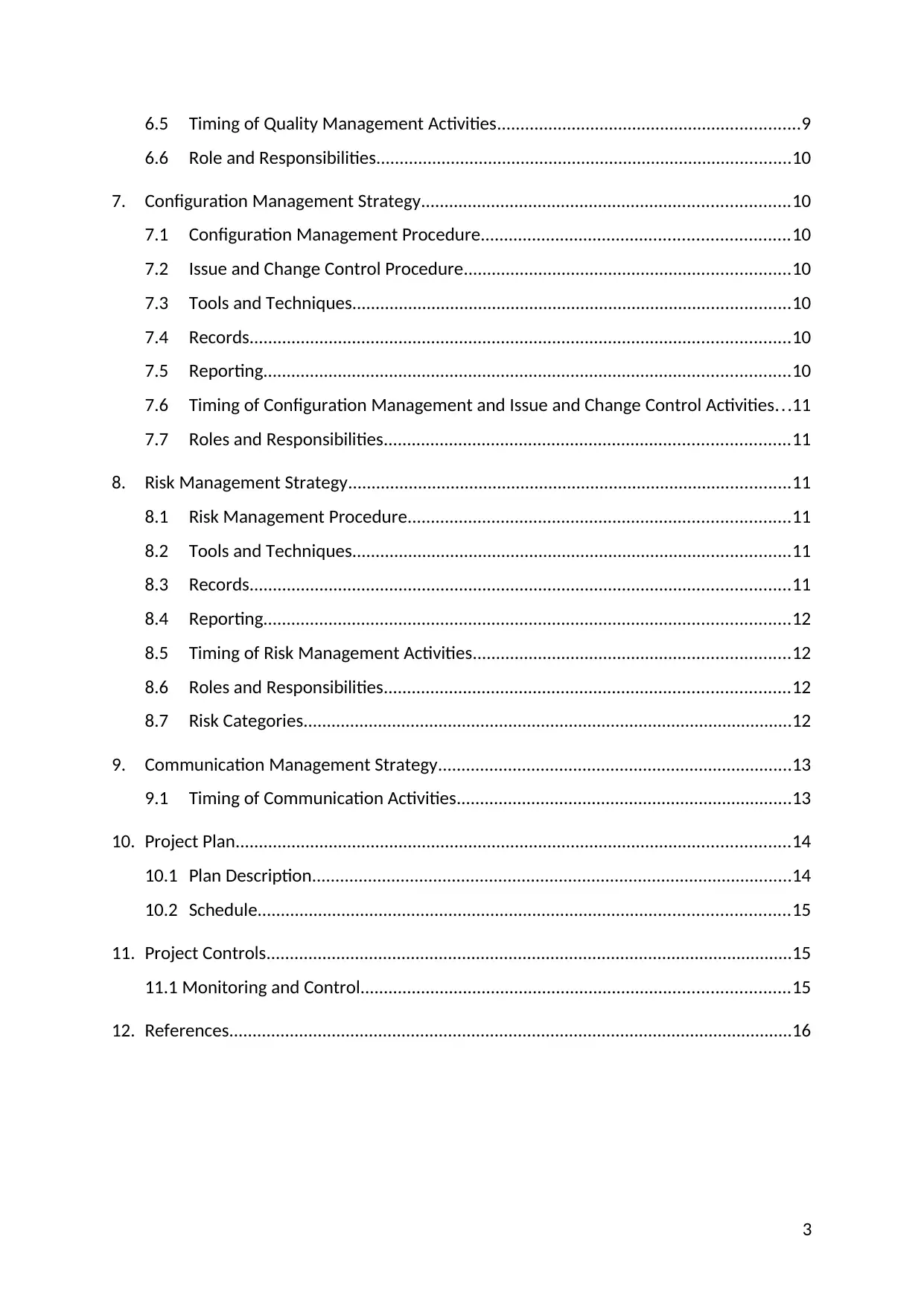
6.5 Timing of Quality Management Activities.................................................................9
6.6 Role and Responsibilities.........................................................................................10
7. Configuration Management Strategy...............................................................................10
7.1 Configuration Management Procedure..................................................................10
7.2 Issue and Change Control Procedure......................................................................10
7.3 Tools and Techniques..............................................................................................10
7.4 Records....................................................................................................................10
7.5 Reporting.................................................................................................................10
7.6 Timing of Configuration Management and Issue and Change Control Activities...11
7.7 Roles and Responsibilities.......................................................................................11
8. Risk Management Strategy...............................................................................................11
8.1 Risk Management Procedure..................................................................................11
8.2 Tools and Techniques..............................................................................................11
8.3 Records....................................................................................................................11
8.4 Reporting.................................................................................................................12
8.5 Timing of Risk Management Activities....................................................................12
8.6 Roles and Responsibilities.......................................................................................12
8.7 Risk Categories.........................................................................................................12
9. Communication Management Strategy............................................................................13
9.1 Timing of Communication Activities........................................................................13
10. Project Plan.......................................................................................................................14
10.1 Plan Description.......................................................................................................14
10.2 Schedule..................................................................................................................15
11. Project Controls.................................................................................................................15
11.1 Monitoring and Control............................................................................................15
12. References.........................................................................................................................16
3
6.6 Role and Responsibilities.........................................................................................10
7. Configuration Management Strategy...............................................................................10
7.1 Configuration Management Procedure..................................................................10
7.2 Issue and Change Control Procedure......................................................................10
7.3 Tools and Techniques..............................................................................................10
7.4 Records....................................................................................................................10
7.5 Reporting.................................................................................................................10
7.6 Timing of Configuration Management and Issue and Change Control Activities...11
7.7 Roles and Responsibilities.......................................................................................11
8. Risk Management Strategy...............................................................................................11
8.1 Risk Management Procedure..................................................................................11
8.2 Tools and Techniques..............................................................................................11
8.3 Records....................................................................................................................11
8.4 Reporting.................................................................................................................12
8.5 Timing of Risk Management Activities....................................................................12
8.6 Roles and Responsibilities.......................................................................................12
8.7 Risk Categories.........................................................................................................12
9. Communication Management Strategy............................................................................13
9.1 Timing of Communication Activities........................................................................13
10. Project Plan.......................................................................................................................14
10.1 Plan Description.......................................................................................................14
10.2 Schedule..................................................................................................................15
11. Project Controls.................................................................................................................15
11.1 Monitoring and Control............................................................................................15
12. References.........................................................................................................................16
3
Secure Best Marks with AI Grader
Need help grading? Try our AI Grader for instant feedback on your assignments.
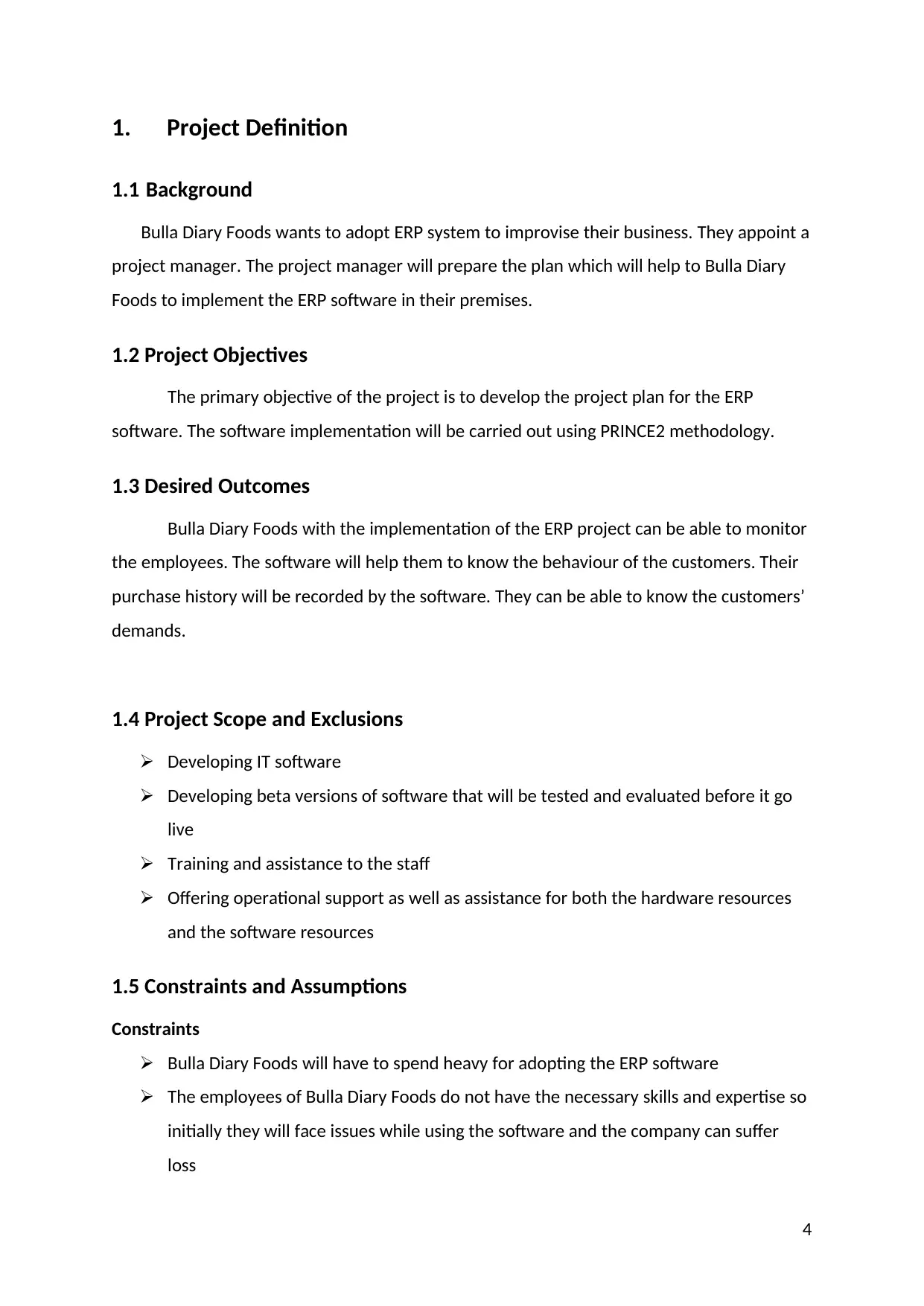
1. Project Definition
1.1 Background
Bulla Diary Foods wants to adopt ERP system to improvise their business. They appoint a
project manager. The project manager will prepare the plan which will help to Bulla Diary
Foods to implement the ERP software in their premises.
1.2 Project Objectives
The primary objective of the project is to develop the project plan for the ERP
software. The software implementation will be carried out using PRINCE2 methodology.
1.3 Desired Outcomes
Bulla Diary Foods with the implementation of the ERP project can be able to monitor
the employees. The software will help them to know the behaviour of the customers. Their
purchase history will be recorded by the software. They can be able to know the customers’
demands.
1.4 Project Scope and Exclusions
Developing IT software
Developing beta versions of software that will be tested and evaluated before it go
live
Training and assistance to the staff
Offering operational support as well as assistance for both the hardware resources
and the software resources
1.5 Constraints and Assumptions
Constraints
Bulla Diary Foods will have to spend heavy for adopting the ERP software
The employees of Bulla Diary Foods do not have the necessary skills and expertise so
initially they will face issues while using the software and the company can suffer
loss
4
1.1 Background
Bulla Diary Foods wants to adopt ERP system to improvise their business. They appoint a
project manager. The project manager will prepare the plan which will help to Bulla Diary
Foods to implement the ERP software in their premises.
1.2 Project Objectives
The primary objective of the project is to develop the project plan for the ERP
software. The software implementation will be carried out using PRINCE2 methodology.
1.3 Desired Outcomes
Bulla Diary Foods with the implementation of the ERP project can be able to monitor
the employees. The software will help them to know the behaviour of the customers. Their
purchase history will be recorded by the software. They can be able to know the customers’
demands.
1.4 Project Scope and Exclusions
Developing IT software
Developing beta versions of software that will be tested and evaluated before it go
live
Training and assistance to the staff
Offering operational support as well as assistance for both the hardware resources
and the software resources
1.5 Constraints and Assumptions
Constraints
Bulla Diary Foods will have to spend heavy for adopting the ERP software
The employees of Bulla Diary Foods do not have the necessary skills and expertise so
initially they will face issues while using the software and the company can suffer
loss
4
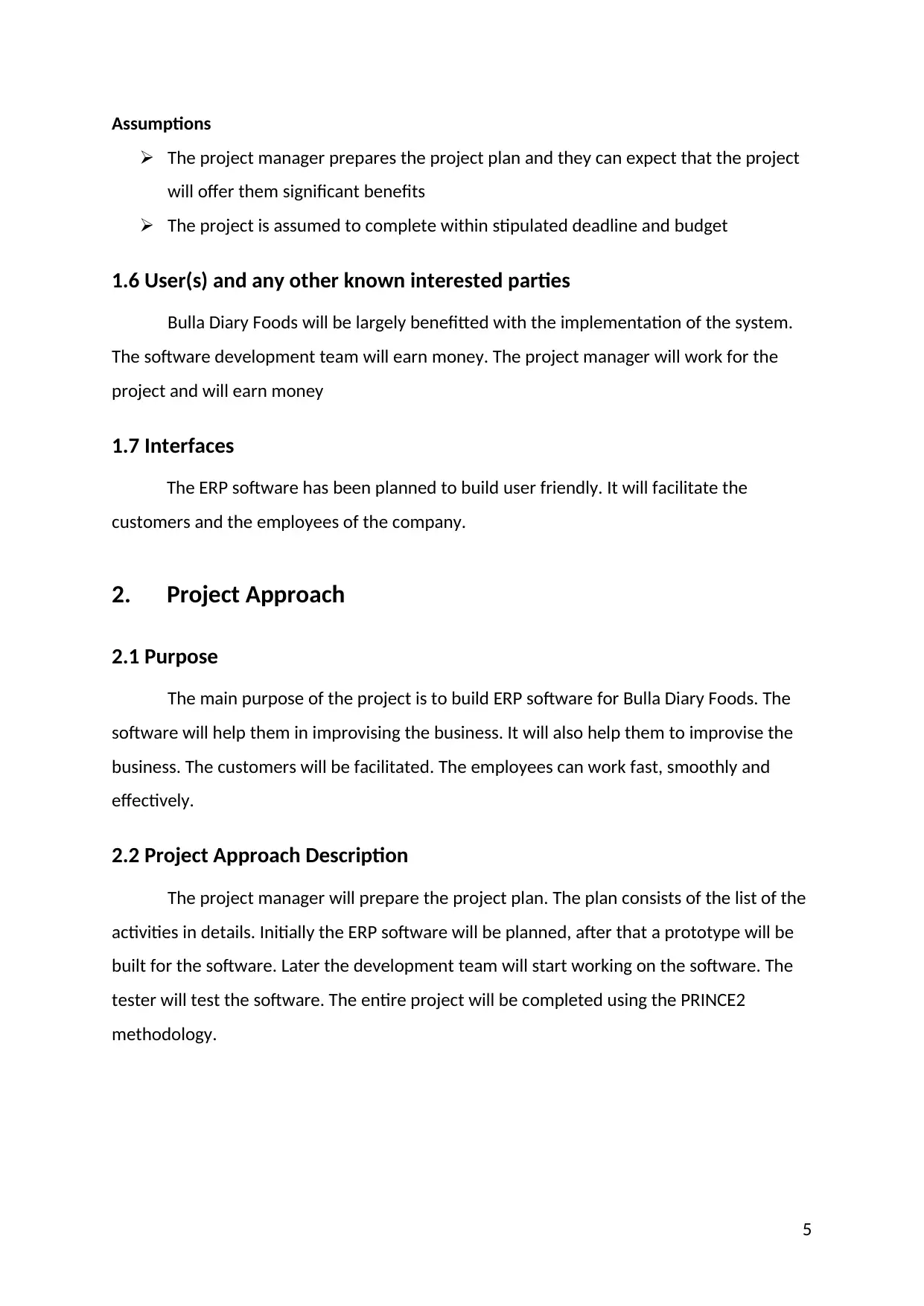
Assumptions
The project manager prepares the project plan and they can expect that the project
will offer them significant benefits
The project is assumed to complete within stipulated deadline and budget
1.6 User(s) and any other known interested parties
Bulla Diary Foods will be largely benefitted with the implementation of the system.
The software development team will earn money. The project manager will work for the
project and will earn money
1.7 Interfaces
The ERP software has been planned to build user friendly. It will facilitate the
customers and the employees of the company.
2. Project Approach
2.1 Purpose
The main purpose of the project is to build ERP software for Bulla Diary Foods. The
software will help them in improvising the business. It will also help them to improvise the
business. The customers will be facilitated. The employees can work fast, smoothly and
effectively.
2.2 Project Approach Description
The project manager will prepare the project plan. The plan consists of the list of the
activities in details. Initially the ERP software will be planned, after that a prototype will be
built for the software. Later the development team will start working on the software. The
tester will test the software. The entire project will be completed using the PRINCE2
methodology.
5
The project manager prepares the project plan and they can expect that the project
will offer them significant benefits
The project is assumed to complete within stipulated deadline and budget
1.6 User(s) and any other known interested parties
Bulla Diary Foods will be largely benefitted with the implementation of the system.
The software development team will earn money. The project manager will work for the
project and will earn money
1.7 Interfaces
The ERP software has been planned to build user friendly. It will facilitate the
customers and the employees of the company.
2. Project Approach
2.1 Purpose
The main purpose of the project is to build ERP software for Bulla Diary Foods. The
software will help them in improvising the business. It will also help them to improvise the
business. The customers will be facilitated. The employees can work fast, smoothly and
effectively.
2.2 Project Approach Description
The project manager will prepare the project plan. The plan consists of the list of the
activities in details. Initially the ERP software will be planned, after that a prototype will be
built for the software. Later the development team will start working on the software. The
tester will test the software. The entire project will be completed using the PRINCE2
methodology.
5
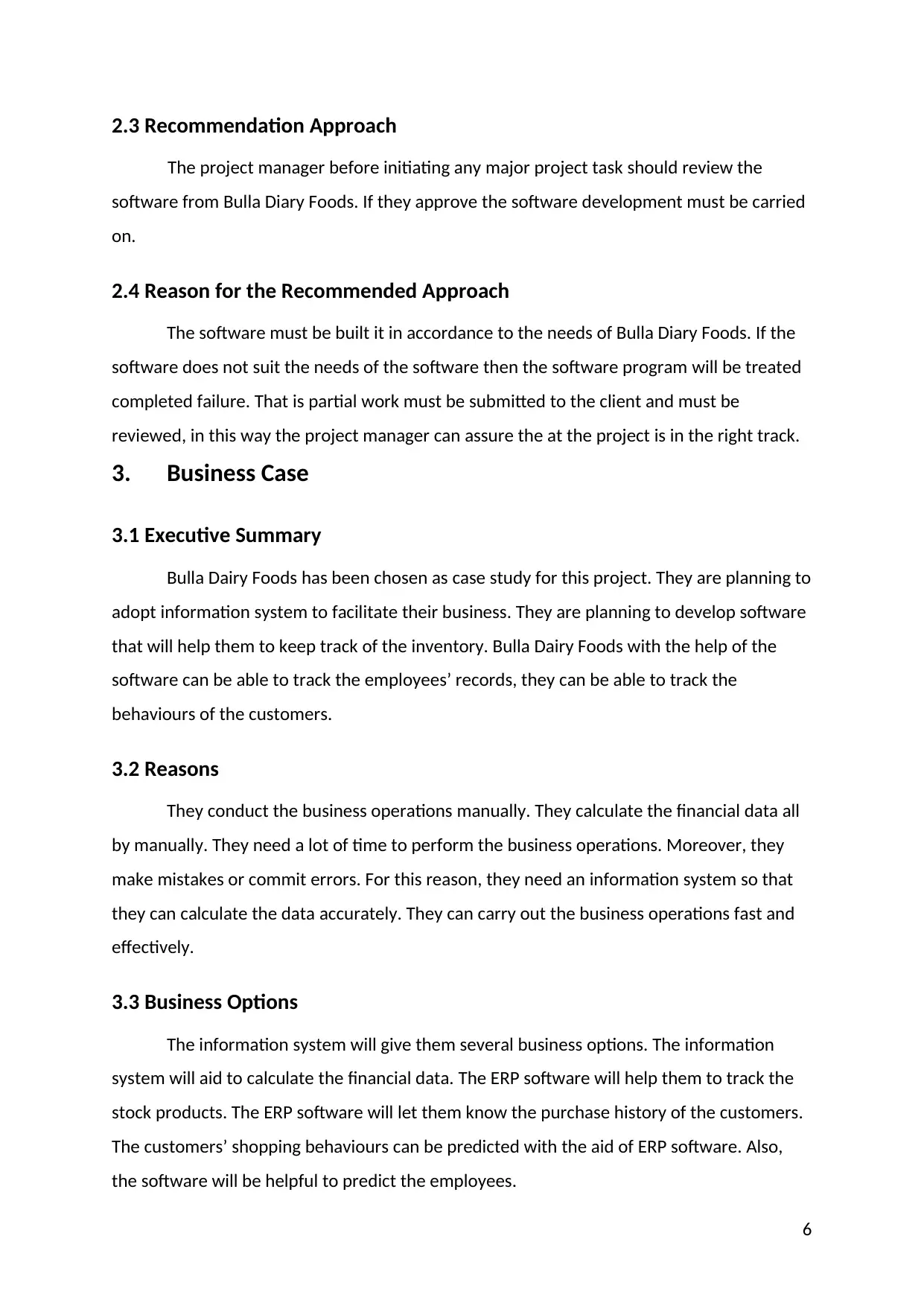
2.3 Recommendation Approach
The project manager before initiating any major project task should review the
software from Bulla Diary Foods. If they approve the software development must be carried
on.
2.4 Reason for the Recommended Approach
The software must be built it in accordance to the needs of Bulla Diary Foods. If the
software does not suit the needs of the software then the software program will be treated
completed failure. That is partial work must be submitted to the client and must be
reviewed, in this way the project manager can assure the at the project is in the right track.
3. Business Case
3.1 Executive Summary
Bulla Dairy Foods has been chosen as case study for this project. They are planning to
adopt information system to facilitate their business. They are planning to develop software
that will help them to keep track of the inventory. Bulla Dairy Foods with the help of the
software can be able to track the employees’ records, they can be able to track the
behaviours of the customers.
3.2 Reasons
They conduct the business operations manually. They calculate the financial data all
by manually. They need a lot of time to perform the business operations. Moreover, they
make mistakes or commit errors. For this reason, they need an information system so that
they can calculate the data accurately. They can carry out the business operations fast and
effectively.
3.3 Business Options
The information system will give them several business options. The information
system will aid to calculate the financial data. The ERP software will help them to track the
stock products. The ERP software will let them know the purchase history of the customers.
The customers’ shopping behaviours can be predicted with the aid of ERP software. Also,
the software will be helpful to predict the employees.
6
The project manager before initiating any major project task should review the
software from Bulla Diary Foods. If they approve the software development must be carried
on.
2.4 Reason for the Recommended Approach
The software must be built it in accordance to the needs of Bulla Diary Foods. If the
software does not suit the needs of the software then the software program will be treated
completed failure. That is partial work must be submitted to the client and must be
reviewed, in this way the project manager can assure the at the project is in the right track.
3. Business Case
3.1 Executive Summary
Bulla Dairy Foods has been chosen as case study for this project. They are planning to
adopt information system to facilitate their business. They are planning to develop software
that will help them to keep track of the inventory. Bulla Dairy Foods with the help of the
software can be able to track the employees’ records, they can be able to track the
behaviours of the customers.
3.2 Reasons
They conduct the business operations manually. They calculate the financial data all
by manually. They need a lot of time to perform the business operations. Moreover, they
make mistakes or commit errors. For this reason, they need an information system so that
they can calculate the data accurately. They can carry out the business operations fast and
effectively.
3.3 Business Options
The information system will give them several business options. The information
system will aid to calculate the financial data. The ERP software will help them to track the
stock products. The ERP software will let them know the purchase history of the customers.
The customers’ shopping behaviours can be predicted with the aid of ERP software. Also,
the software will be helpful to predict the employees.
6
Paraphrase This Document
Need a fresh take? Get an instant paraphrase of this document with our AI Paraphraser
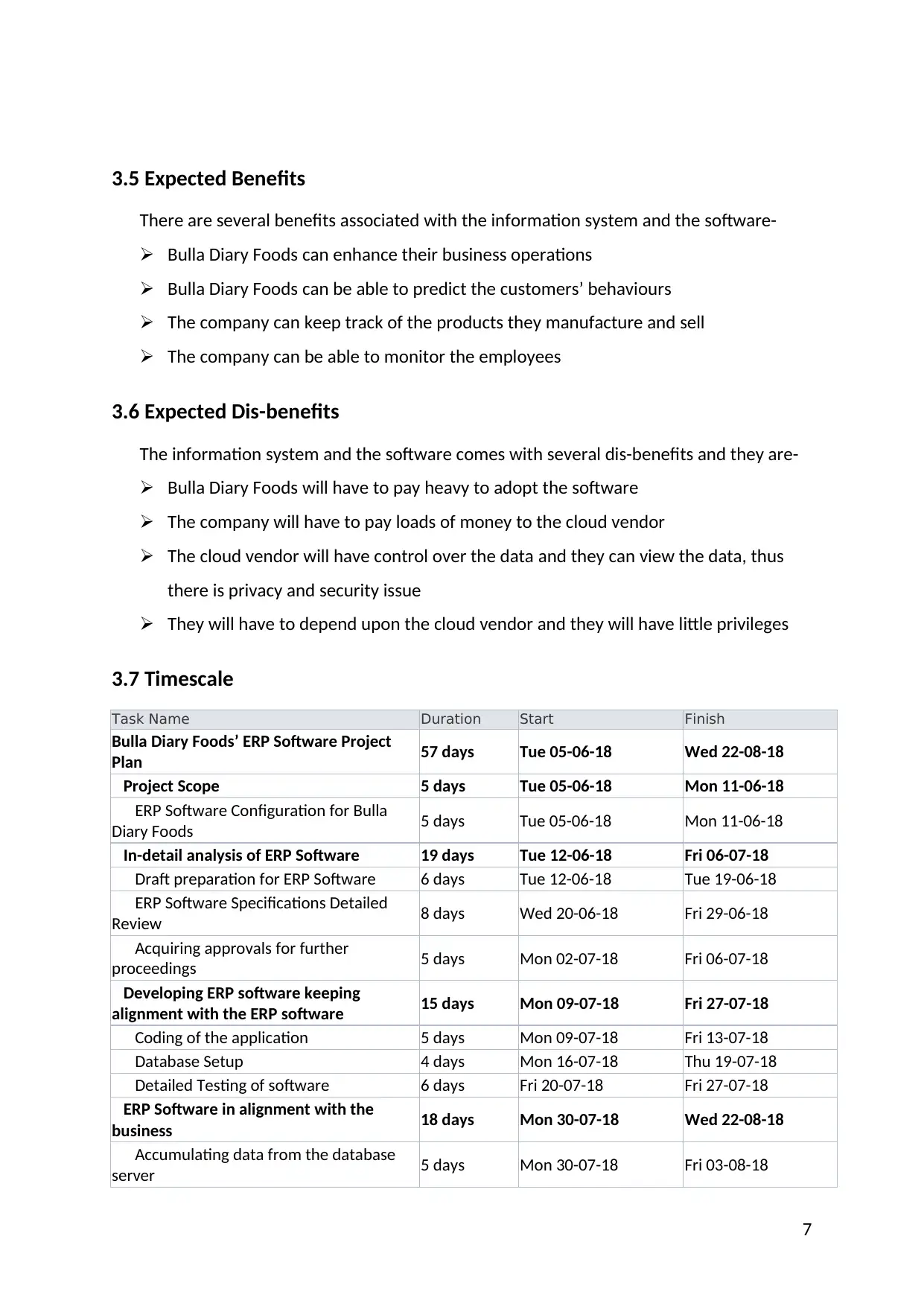
3.5 Expected Benefits
There are several benefits associated with the information system and the software-
Bulla Diary Foods can enhance their business operations
Bulla Diary Foods can be able to predict the customers’ behaviours
The company can keep track of the products they manufacture and sell
The company can be able to monitor the employees
3.6 Expected Dis-benefits
The information system and the software comes with several dis-benefits and they are-
Bulla Diary Foods will have to pay heavy to adopt the software
The company will have to pay loads of money to the cloud vendor
The cloud vendor will have control over the data and they can view the data, thus
there is privacy and security issue
They will have to depend upon the cloud vendor and they will have little privileges
3.7 Timescale
Task Name Duration Start Finish
Bulla Diary Foods’ ERP Software Project
Plan 57 days Tue 05-06-18 Wed 22-08-18
Project Scope 5 days Tue 05-06-18 Mon 11-06-18
ERP Software Configuration for Bulla
Diary Foods 5 days Tue 05-06-18 Mon 11-06-18
In-detail analysis of ERP Software 19 days Tue 12-06-18 Fri 06-07-18
Draft preparation for ERP Software 6 days Tue 12-06-18 Tue 19-06-18
ERP Software Specifications Detailed
Review 8 days Wed 20-06-18 Fri 29-06-18
Acquiring approvals for further
proceedings 5 days Mon 02-07-18 Fri 06-07-18
Developing ERP software keeping
alignment with the ERP software 15 days Mon 09-07-18 Fri 27-07-18
Coding of the application 5 days Mon 09-07-18 Fri 13-07-18
Database Setup 4 days Mon 16-07-18 Thu 19-07-18
Detailed Testing of software 6 days Fri 20-07-18 Fri 27-07-18
ERP Software in alignment with the
business 18 days Mon 30-07-18 Wed 22-08-18
Accumulating data from the database
server 5 days Mon 30-07-18 Fri 03-08-18
7
There are several benefits associated with the information system and the software-
Bulla Diary Foods can enhance their business operations
Bulla Diary Foods can be able to predict the customers’ behaviours
The company can keep track of the products they manufacture and sell
The company can be able to monitor the employees
3.6 Expected Dis-benefits
The information system and the software comes with several dis-benefits and they are-
Bulla Diary Foods will have to pay heavy to adopt the software
The company will have to pay loads of money to the cloud vendor
The cloud vendor will have control over the data and they can view the data, thus
there is privacy and security issue
They will have to depend upon the cloud vendor and they will have little privileges
3.7 Timescale
Task Name Duration Start Finish
Bulla Diary Foods’ ERP Software Project
Plan 57 days Tue 05-06-18 Wed 22-08-18
Project Scope 5 days Tue 05-06-18 Mon 11-06-18
ERP Software Configuration for Bulla
Diary Foods 5 days Tue 05-06-18 Mon 11-06-18
In-detail analysis of ERP Software 19 days Tue 12-06-18 Fri 06-07-18
Draft preparation for ERP Software 6 days Tue 12-06-18 Tue 19-06-18
ERP Software Specifications Detailed
Review 8 days Wed 20-06-18 Fri 29-06-18
Acquiring approvals for further
proceedings 5 days Mon 02-07-18 Fri 06-07-18
Developing ERP software keeping
alignment with the ERP software 15 days Mon 09-07-18 Fri 27-07-18
Coding of the application 5 days Mon 09-07-18 Fri 13-07-18
Database Setup 4 days Mon 16-07-18 Thu 19-07-18
Detailed Testing of software 6 days Fri 20-07-18 Fri 27-07-18
ERP Software in alignment with the
business 18 days Mon 30-07-18 Wed 22-08-18
Accumulating data from the database
server 5 days Mon 30-07-18 Fri 03-08-18
7
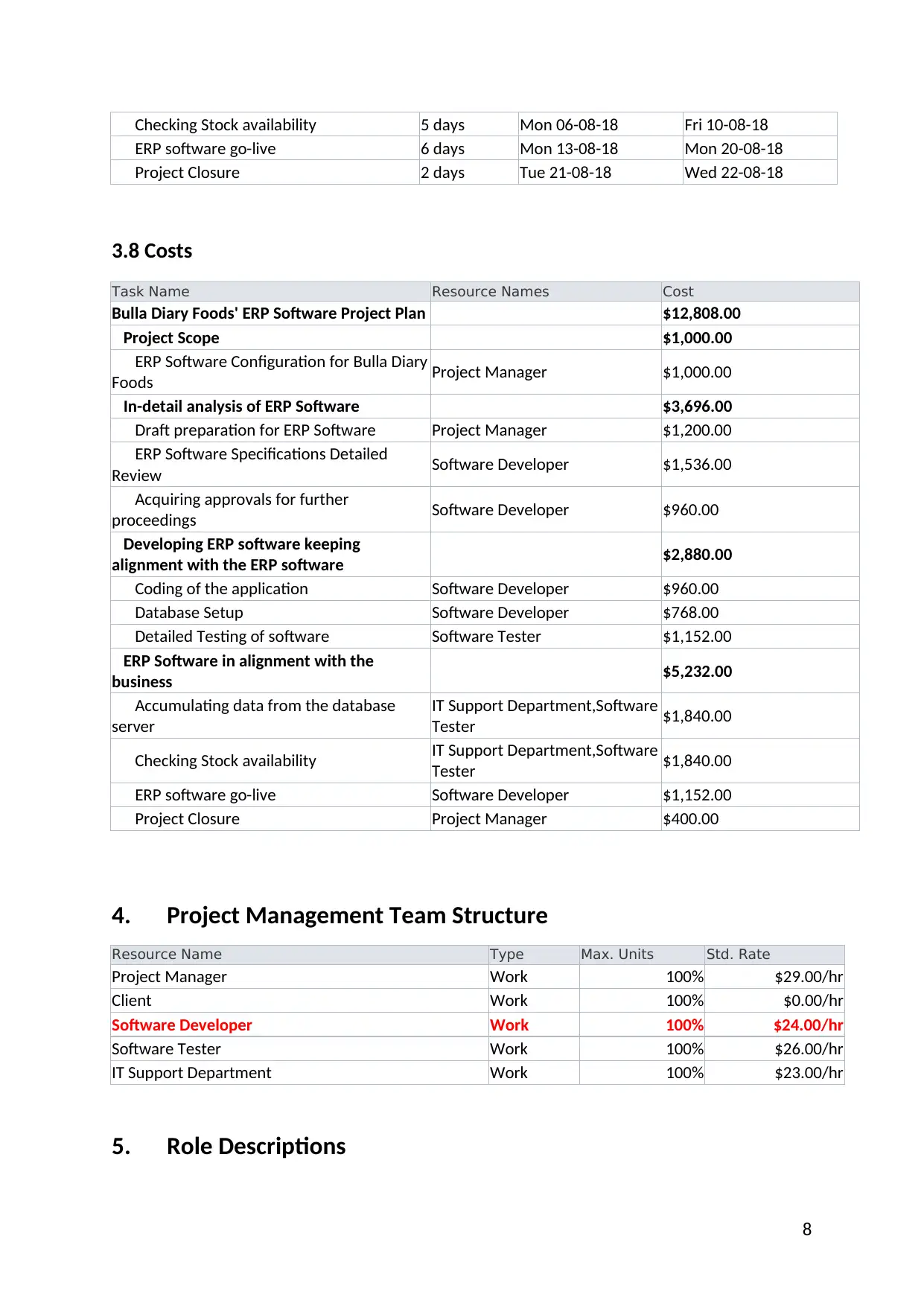
Checking Stock availability 5 days Mon 06-08-18 Fri 10-08-18
ERP software go-live 6 days Mon 13-08-18 Mon 20-08-18
Project Closure 2 days Tue 21-08-18 Wed 22-08-18
3.8 Costs
Task Name Resource Names Cost
Bulla Diary Foods' ERP Software Project Plan $12,808.00
Project Scope $1,000.00
ERP Software Configuration for Bulla Diary
Foods Project Manager $1,000.00
In-detail analysis of ERP Software $3,696.00
Draft preparation for ERP Software Project Manager $1,200.00
ERP Software Specifications Detailed
Review Software Developer $1,536.00
Acquiring approvals for further
proceedings Software Developer $960.00
Developing ERP software keeping
alignment with the ERP software $2,880.00
Coding of the application Software Developer $960.00
Database Setup Software Developer $768.00
Detailed Testing of software Software Tester $1,152.00
ERP Software in alignment with the
business $5,232.00
Accumulating data from the database
server
IT Support Department,Software
Tester $1,840.00
Checking Stock availability IT Support Department,Software
Tester $1,840.00
ERP software go-live Software Developer $1,152.00
Project Closure Project Manager $400.00
4. Project Management Team Structure
Resource Name Type Max. Units Std. Rate
Project Manager Work 100% $29.00/hr
Client Work 100% $0.00/hr
Software Developer Work 100% $24.00/hr
Software Tester Work 100% $26.00/hr
IT Support Department Work 100% $23.00/hr
5. Role Descriptions
8
ERP software go-live 6 days Mon 13-08-18 Mon 20-08-18
Project Closure 2 days Tue 21-08-18 Wed 22-08-18
3.8 Costs
Task Name Resource Names Cost
Bulla Diary Foods' ERP Software Project Plan $12,808.00
Project Scope $1,000.00
ERP Software Configuration for Bulla Diary
Foods Project Manager $1,000.00
In-detail analysis of ERP Software $3,696.00
Draft preparation for ERP Software Project Manager $1,200.00
ERP Software Specifications Detailed
Review Software Developer $1,536.00
Acquiring approvals for further
proceedings Software Developer $960.00
Developing ERP software keeping
alignment with the ERP software $2,880.00
Coding of the application Software Developer $960.00
Database Setup Software Developer $768.00
Detailed Testing of software Software Tester $1,152.00
ERP Software in alignment with the
business $5,232.00
Accumulating data from the database
server
IT Support Department,Software
Tester $1,840.00
Checking Stock availability IT Support Department,Software
Tester $1,840.00
ERP software go-live Software Developer $1,152.00
Project Closure Project Manager $400.00
4. Project Management Team Structure
Resource Name Type Max. Units Std. Rate
Project Manager Work 100% $29.00/hr
Client Work 100% $0.00/hr
Software Developer Work 100% $24.00/hr
Software Tester Work 100% $26.00/hr
IT Support Department Work 100% $23.00/hr
5. Role Descriptions
8
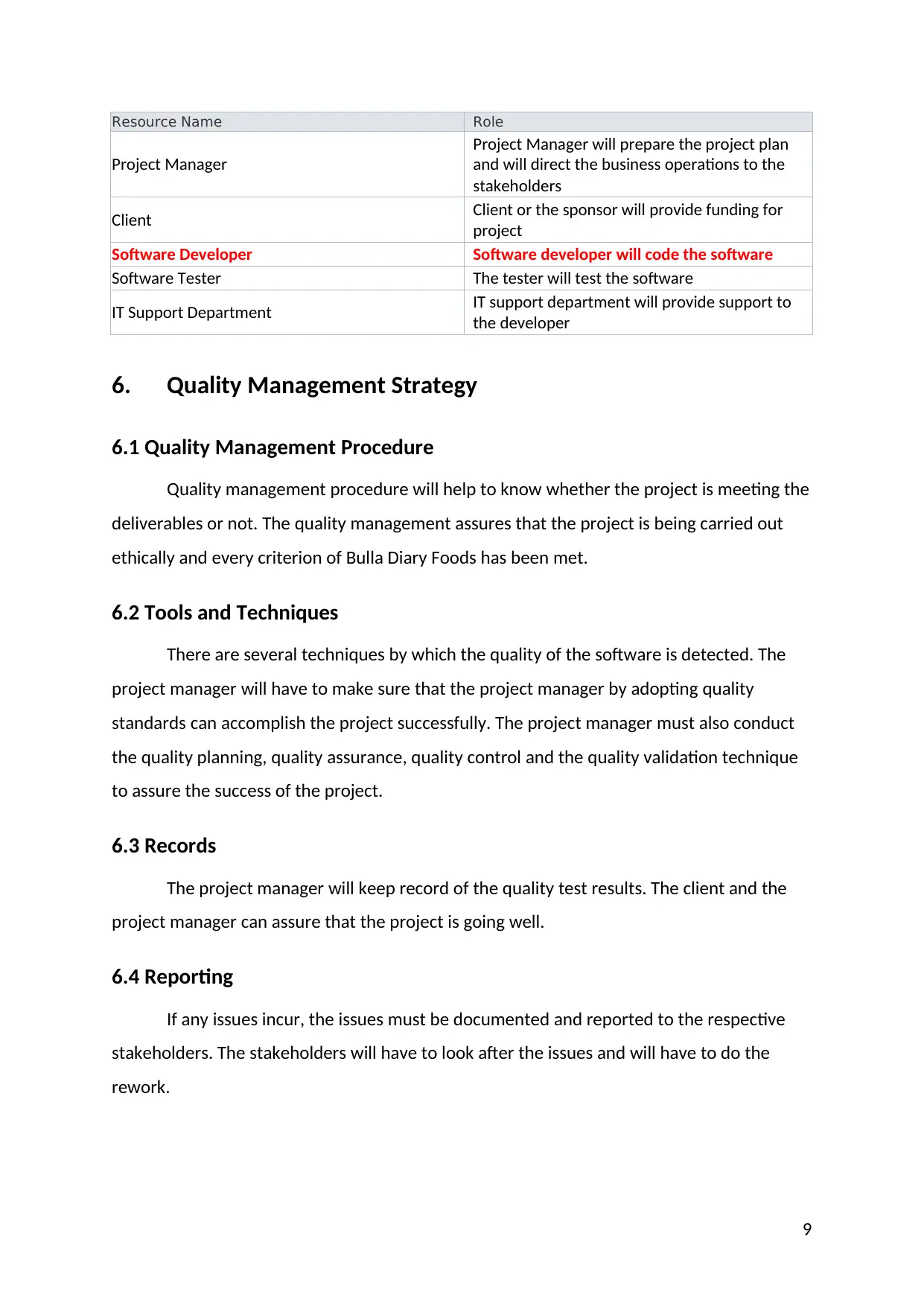
Resource Name Role
Project Manager
Project Manager will prepare the project plan
and will direct the business operations to the
stakeholders
Client Client or the sponsor will provide funding for
project
Software Developer Software developer will code the software
Software Tester The tester will test the software
IT Support Department IT support department will provide support to
the developer
6. Quality Management Strategy
6.1 Quality Management Procedure
Quality management procedure will help to know whether the project is meeting the
deliverables or not. The quality management assures that the project is being carried out
ethically and every criterion of Bulla Diary Foods has been met.
6.2 Tools and Techniques
There are several techniques by which the quality of the software is detected. The
project manager will have to make sure that the project manager by adopting quality
standards can accomplish the project successfully. The project manager must also conduct
the quality planning, quality assurance, quality control and the quality validation technique
to assure the success of the project.
6.3 Records
The project manager will keep record of the quality test results. The client and the
project manager can assure that the project is going well.
6.4 Reporting
If any issues incur, the issues must be documented and reported to the respective
stakeholders. The stakeholders will have to look after the issues and will have to do the
rework.
9
Project Manager
Project Manager will prepare the project plan
and will direct the business operations to the
stakeholders
Client Client or the sponsor will provide funding for
project
Software Developer Software developer will code the software
Software Tester The tester will test the software
IT Support Department IT support department will provide support to
the developer
6. Quality Management Strategy
6.1 Quality Management Procedure
Quality management procedure will help to know whether the project is meeting the
deliverables or not. The quality management assures that the project is being carried out
ethically and every criterion of Bulla Diary Foods has been met.
6.2 Tools and Techniques
There are several techniques by which the quality of the software is detected. The
project manager will have to make sure that the project manager by adopting quality
standards can accomplish the project successfully. The project manager must also conduct
the quality planning, quality assurance, quality control and the quality validation technique
to assure the success of the project.
6.3 Records
The project manager will keep record of the quality test results. The client and the
project manager can assure that the project is going well.
6.4 Reporting
If any issues incur, the issues must be documented and reported to the respective
stakeholders. The stakeholders will have to look after the issues and will have to do the
rework.
9
Secure Best Marks with AI Grader
Need help grading? Try our AI Grader for instant feedback on your assignments.
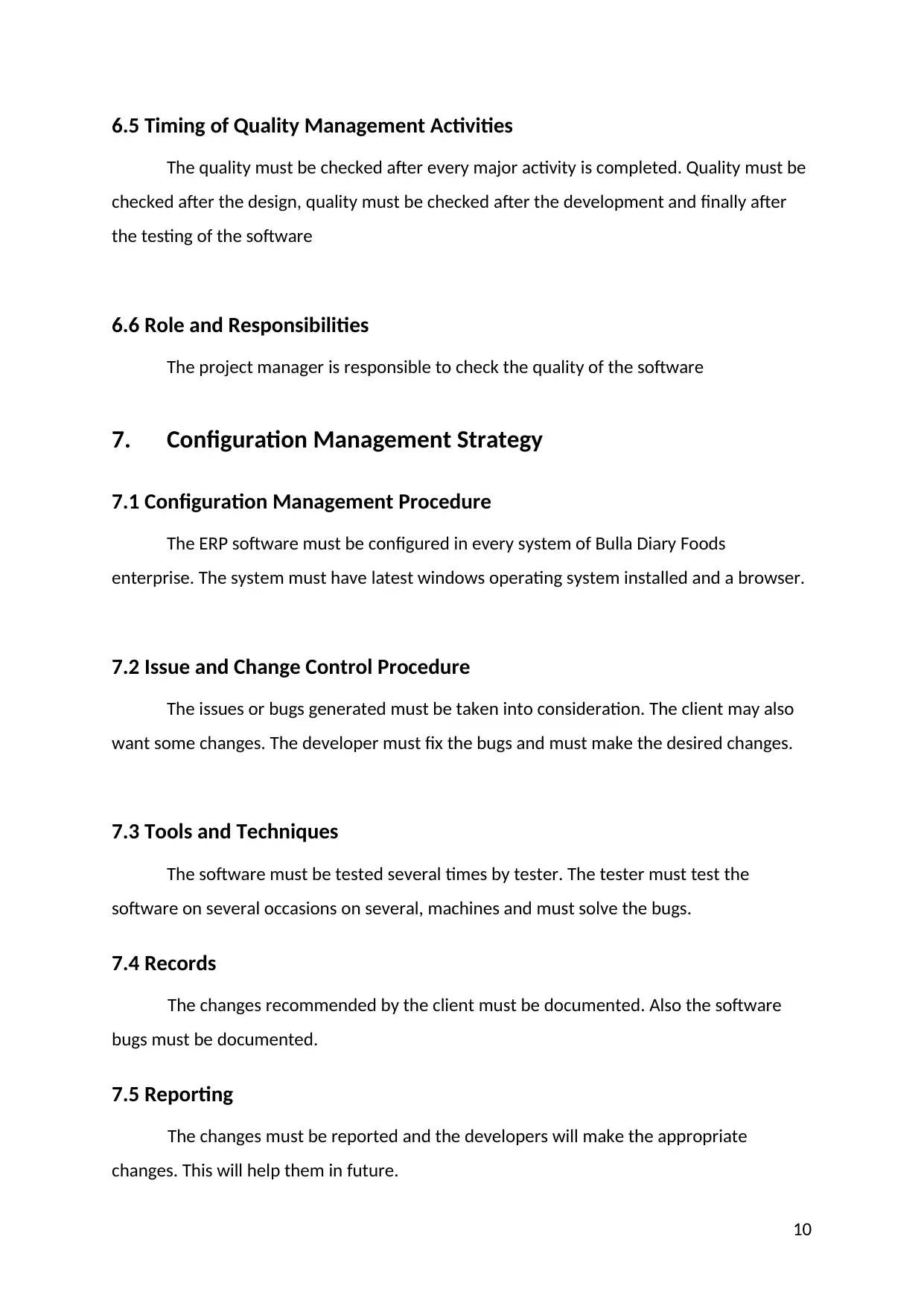
6.5 Timing of Quality Management Activities
The quality must be checked after every major activity is completed. Quality must be
checked after the design, quality must be checked after the development and finally after
the testing of the software
6.6 Role and Responsibilities
The project manager is responsible to check the quality of the software
7. Configuration Management Strategy
7.1 Configuration Management Procedure
The ERP software must be configured in every system of Bulla Diary Foods
enterprise. The system must have latest windows operating system installed and a browser.
7.2 Issue and Change Control Procedure
The issues or bugs generated must be taken into consideration. The client may also
want some changes. The developer must fix the bugs and must make the desired changes.
7.3 Tools and Techniques
The software must be tested several times by tester. The tester must test the
software on several occasions on several, machines and must solve the bugs.
7.4 Records
The changes recommended by the client must be documented. Also the software
bugs must be documented.
7.5 Reporting
The changes must be reported and the developers will make the appropriate
changes. This will help them in future.
10
The quality must be checked after every major activity is completed. Quality must be
checked after the design, quality must be checked after the development and finally after
the testing of the software
6.6 Role and Responsibilities
The project manager is responsible to check the quality of the software
7. Configuration Management Strategy
7.1 Configuration Management Procedure
The ERP software must be configured in every system of Bulla Diary Foods
enterprise. The system must have latest windows operating system installed and a browser.
7.2 Issue and Change Control Procedure
The issues or bugs generated must be taken into consideration. The client may also
want some changes. The developer must fix the bugs and must make the desired changes.
7.3 Tools and Techniques
The software must be tested several times by tester. The tester must test the
software on several occasions on several, machines and must solve the bugs.
7.4 Records
The changes recommended by the client must be documented. Also the software
bugs must be documented.
7.5 Reporting
The changes must be reported and the developers will make the appropriate
changes. This will help them in future.
10
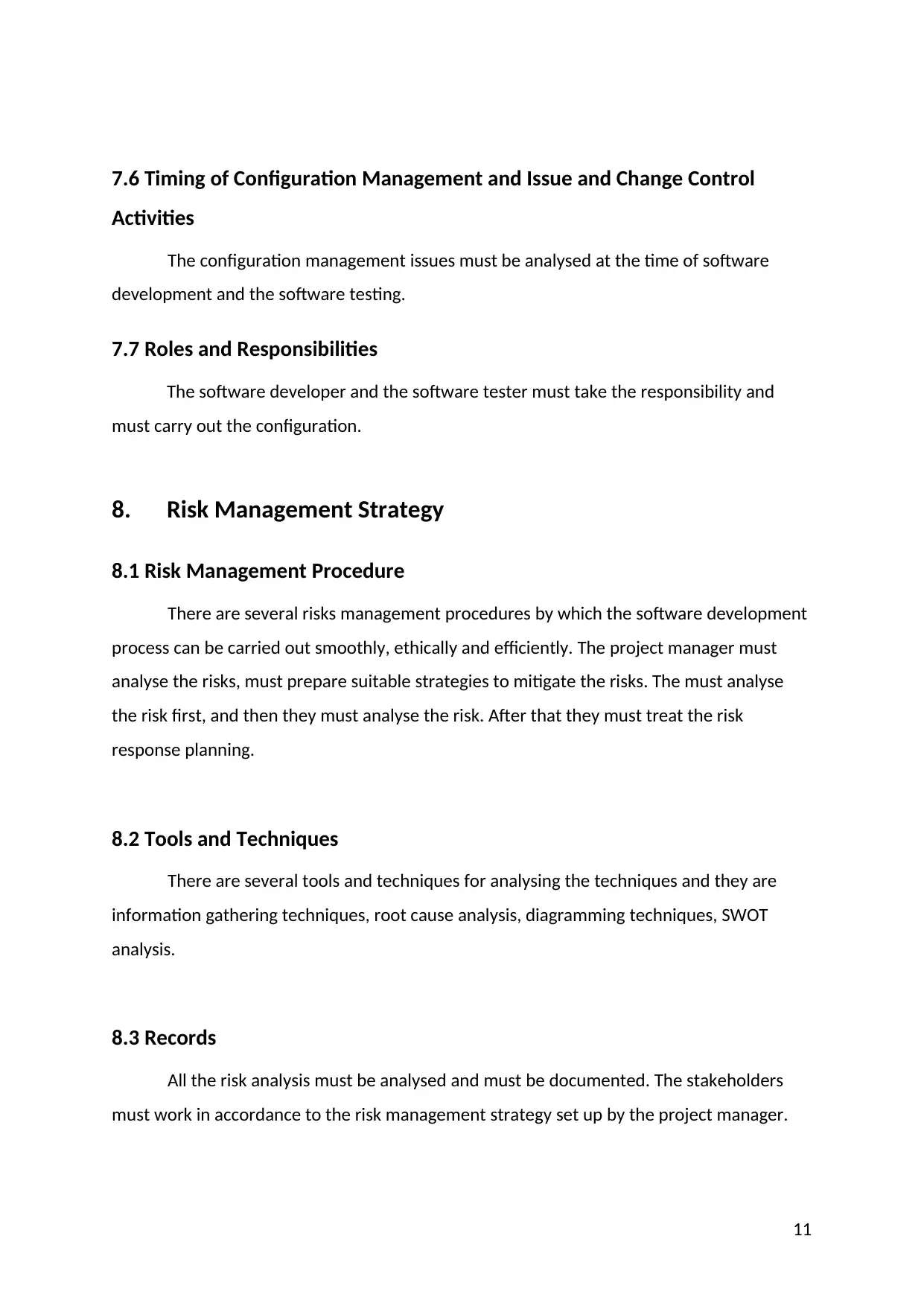
7.6 Timing of Configuration Management and Issue and Change Control
Activities
The configuration management issues must be analysed at the time of software
development and the software testing.
7.7 Roles and Responsibilities
The software developer and the software tester must take the responsibility and
must carry out the configuration.
8. Risk Management Strategy
8.1 Risk Management Procedure
There are several risks management procedures by which the software development
process can be carried out smoothly, ethically and efficiently. The project manager must
analyse the risks, must prepare suitable strategies to mitigate the risks. The must analyse
the risk first, and then they must analyse the risk. After that they must treat the risk
response planning.
8.2 Tools and Techniques
There are several tools and techniques for analysing the techniques and they are
information gathering techniques, root cause analysis, diagramming techniques, SWOT
analysis.
8.3 Records
All the risk analysis must be analysed and must be documented. The stakeholders
must work in accordance to the risk management strategy set up by the project manager.
11
Activities
The configuration management issues must be analysed at the time of software
development and the software testing.
7.7 Roles and Responsibilities
The software developer and the software tester must take the responsibility and
must carry out the configuration.
8. Risk Management Strategy
8.1 Risk Management Procedure
There are several risks management procedures by which the software development
process can be carried out smoothly, ethically and efficiently. The project manager must
analyse the risks, must prepare suitable strategies to mitigate the risks. The must analyse
the risk first, and then they must analyse the risk. After that they must treat the risk
response planning.
8.2 Tools and Techniques
There are several tools and techniques for analysing the techniques and they are
information gathering techniques, root cause analysis, diagramming techniques, SWOT
analysis.
8.3 Records
All the risk analysis must be analysed and must be documented. The stakeholders
must work in accordance to the risk management strategy set up by the project manager.
11
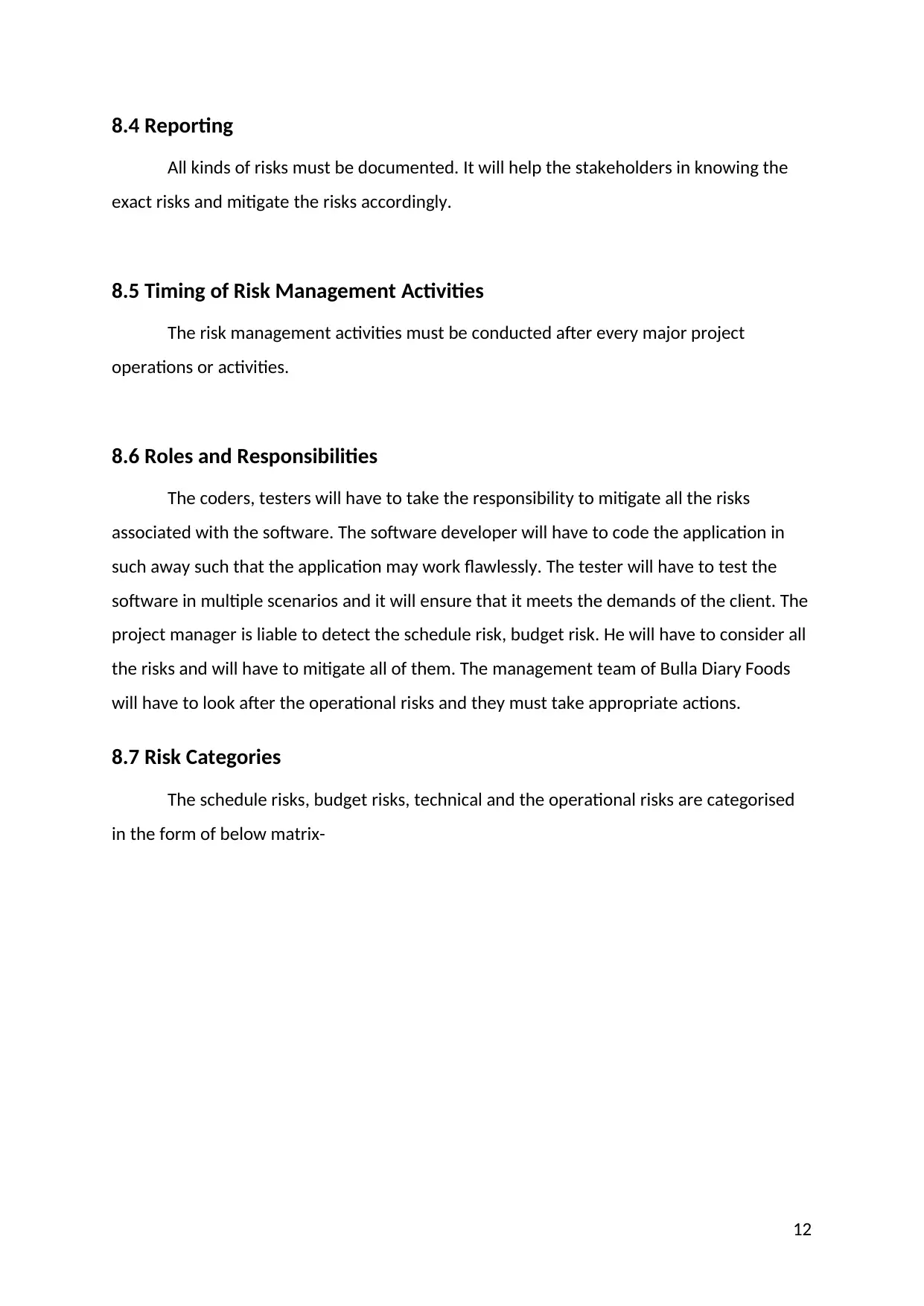
8.4 Reporting
All kinds of risks must be documented. It will help the stakeholders in knowing the
exact risks and mitigate the risks accordingly.
8.5 Timing of Risk Management Activities
The risk management activities must be conducted after every major project
operations or activities.
8.6 Roles and Responsibilities
The coders, testers will have to take the responsibility to mitigate all the risks
associated with the software. The software developer will have to code the application in
such away such that the application may work flawlessly. The tester will have to test the
software in multiple scenarios and it will ensure that it meets the demands of the client. The
project manager is liable to detect the schedule risk, budget risk. He will have to consider all
the risks and will have to mitigate all of them. The management team of Bulla Diary Foods
will have to look after the operational risks and they must take appropriate actions.
8.7 Risk Categories
The schedule risks, budget risks, technical and the operational risks are categorised
in the form of below matrix-
12
All kinds of risks must be documented. It will help the stakeholders in knowing the
exact risks and mitigate the risks accordingly.
8.5 Timing of Risk Management Activities
The risk management activities must be conducted after every major project
operations or activities.
8.6 Roles and Responsibilities
The coders, testers will have to take the responsibility to mitigate all the risks
associated with the software. The software developer will have to code the application in
such away such that the application may work flawlessly. The tester will have to test the
software in multiple scenarios and it will ensure that it meets the demands of the client. The
project manager is liable to detect the schedule risk, budget risk. He will have to consider all
the risks and will have to mitigate all of them. The management team of Bulla Diary Foods
will have to look after the operational risks and they must take appropriate actions.
8.7 Risk Categories
The schedule risks, budget risks, technical and the operational risks are categorised
in the form of below matrix-
12
Paraphrase This Document
Need a fresh take? Get an instant paraphrase of this document with our AI Paraphraser
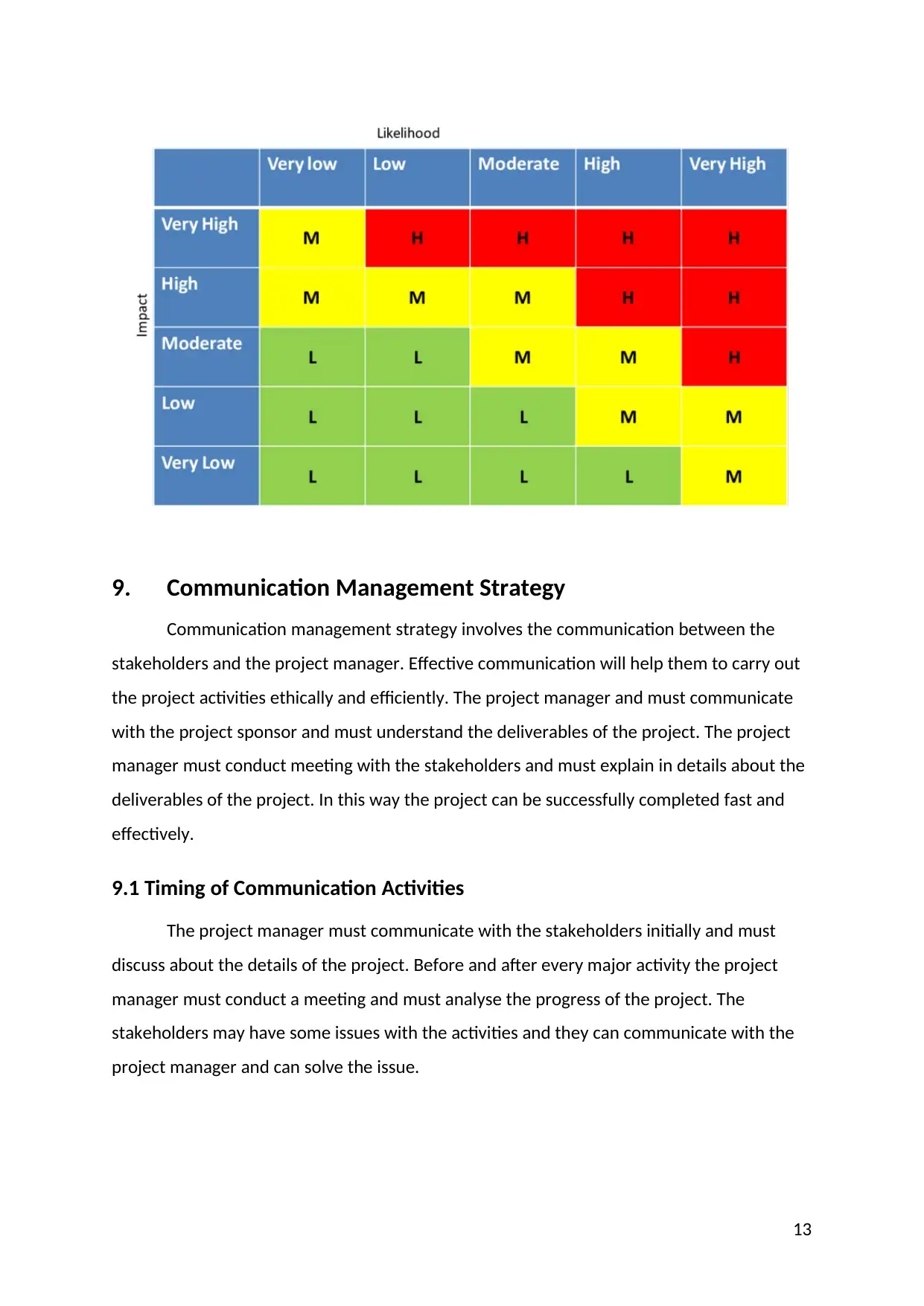
9. Communication Management Strategy
Communication management strategy involves the communication between the
stakeholders and the project manager. Effective communication will help them to carry out
the project activities ethically and efficiently. The project manager and must communicate
with the project sponsor and must understand the deliverables of the project. The project
manager must conduct meeting with the stakeholders and must explain in details about the
deliverables of the project. In this way the project can be successfully completed fast and
effectively.
9.1 Timing of Communication Activities
The project manager must communicate with the stakeholders initially and must
discuss about the details of the project. Before and after every major activity the project
manager must conduct a meeting and must analyse the progress of the project. The
stakeholders may have some issues with the activities and they can communicate with the
project manager and can solve the issue.
13
Communication management strategy involves the communication between the
stakeholders and the project manager. Effective communication will help them to carry out
the project activities ethically and efficiently. The project manager and must communicate
with the project sponsor and must understand the deliverables of the project. The project
manager must conduct meeting with the stakeholders and must explain in details about the
deliverables of the project. In this way the project can be successfully completed fast and
effectively.
9.1 Timing of Communication Activities
The project manager must communicate with the stakeholders initially and must
discuss about the details of the project. Before and after every major activity the project
manager must conduct a meeting and must analyse the progress of the project. The
stakeholders may have some issues with the activities and they can communicate with the
project manager and can solve the issue.
13
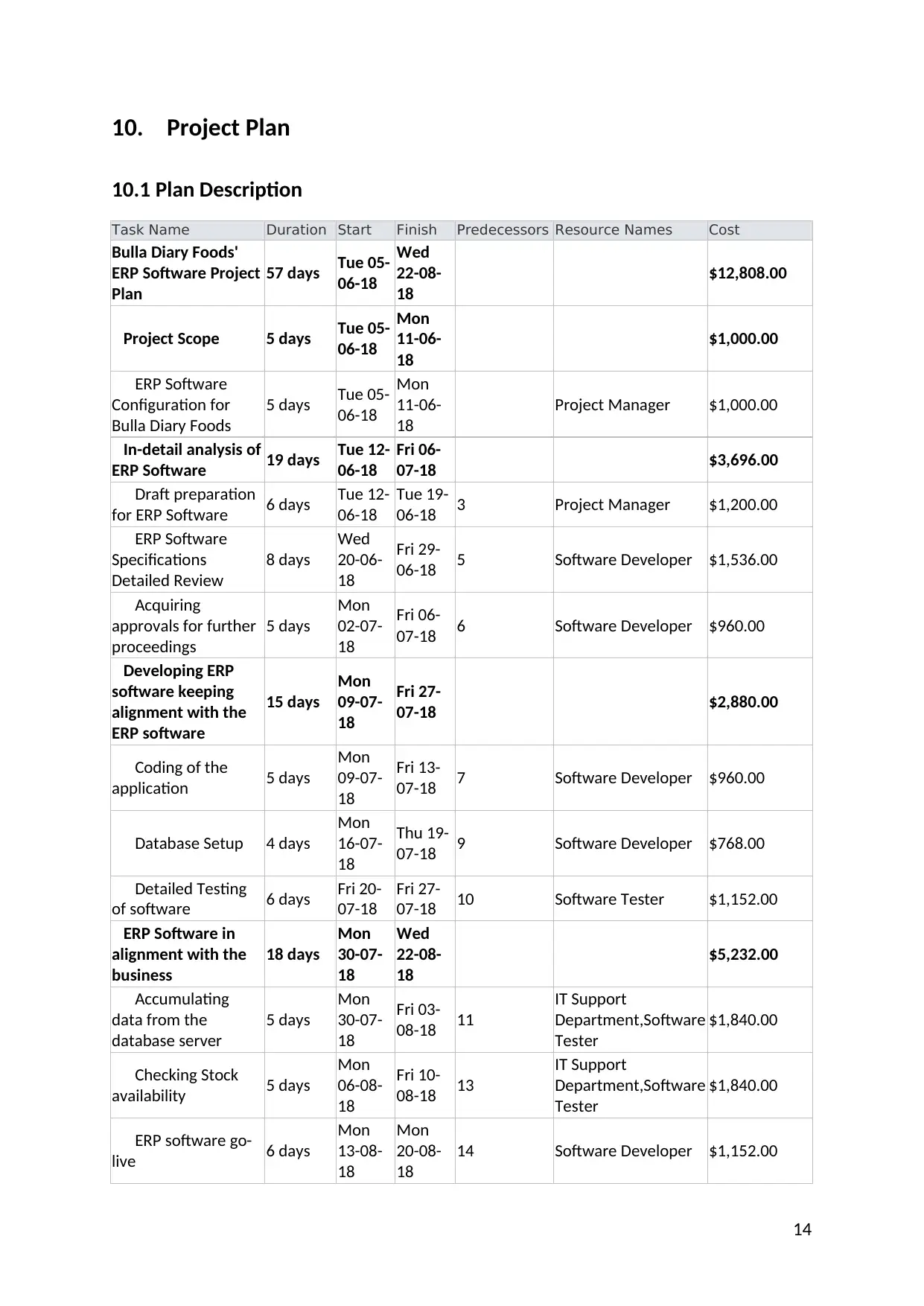
10. Project Plan
10.1 Plan Description
Task Name Duration Start Finish Predecessors Resource Names Cost
Bulla Diary Foods'
ERP Software Project
Plan
57 days Tue 05-
06-18
Wed
22-08-
18
$12,808.00
Project Scope 5 days Tue 05-
06-18
Mon
11-06-
18
$1,000.00
ERP Software
Configuration for
Bulla Diary Foods
5 days Tue 05-
06-18
Mon
11-06-
18
Project Manager $1,000.00
In-detail analysis of
ERP Software 19 days Tue 12-
06-18
Fri 06-
07-18 $3,696.00
Draft preparation
for ERP Software 6 days Tue 12-
06-18
Tue 19-
06-18 3 Project Manager $1,200.00
ERP Software
Specifications
Detailed Review
8 days
Wed
20-06-
18
Fri 29-
06-18 5 Software Developer $1,536.00
Acquiring
approvals for further
proceedings
5 days
Mon
02-07-
18
Fri 06-
07-18 6 Software Developer $960.00
Developing ERP
software keeping
alignment with the
ERP software
15 days
Mon
09-07-
18
Fri 27-
07-18 $2,880.00
Coding of the
application 5 days
Mon
09-07-
18
Fri 13-
07-18 7 Software Developer $960.00
Database Setup 4 days
Mon
16-07-
18
Thu 19-
07-18 9 Software Developer $768.00
Detailed Testing
of software 6 days Fri 20-
07-18
Fri 27-
07-18 10 Software Tester $1,152.00
ERP Software in
alignment with the
business
18 days
Mon
30-07-
18
Wed
22-08-
18
$5,232.00
Accumulating
data from the
database server
5 days
Mon
30-07-
18
Fri 03-
08-18 11
IT Support
Department,Software
Tester
$1,840.00
Checking Stock
availability 5 days
Mon
06-08-
18
Fri 10-
08-18 13
IT Support
Department,Software
Tester
$1,840.00
ERP software go-
live 6 days
Mon
13-08-
18
Mon
20-08-
18
14 Software Developer $1,152.00
14
10.1 Plan Description
Task Name Duration Start Finish Predecessors Resource Names Cost
Bulla Diary Foods'
ERP Software Project
Plan
57 days Tue 05-
06-18
Wed
22-08-
18
$12,808.00
Project Scope 5 days Tue 05-
06-18
Mon
11-06-
18
$1,000.00
ERP Software
Configuration for
Bulla Diary Foods
5 days Tue 05-
06-18
Mon
11-06-
18
Project Manager $1,000.00
In-detail analysis of
ERP Software 19 days Tue 12-
06-18
Fri 06-
07-18 $3,696.00
Draft preparation
for ERP Software 6 days Tue 12-
06-18
Tue 19-
06-18 3 Project Manager $1,200.00
ERP Software
Specifications
Detailed Review
8 days
Wed
20-06-
18
Fri 29-
06-18 5 Software Developer $1,536.00
Acquiring
approvals for further
proceedings
5 days
Mon
02-07-
18
Fri 06-
07-18 6 Software Developer $960.00
Developing ERP
software keeping
alignment with the
ERP software
15 days
Mon
09-07-
18
Fri 27-
07-18 $2,880.00
Coding of the
application 5 days
Mon
09-07-
18
Fri 13-
07-18 7 Software Developer $960.00
Database Setup 4 days
Mon
16-07-
18
Thu 19-
07-18 9 Software Developer $768.00
Detailed Testing
of software 6 days Fri 20-
07-18
Fri 27-
07-18 10 Software Tester $1,152.00
ERP Software in
alignment with the
business
18 days
Mon
30-07-
18
Wed
22-08-
18
$5,232.00
Accumulating
data from the
database server
5 days
Mon
30-07-
18
Fri 03-
08-18 11
IT Support
Department,Software
Tester
$1,840.00
Checking Stock
availability 5 days
Mon
06-08-
18
Fri 10-
08-18 13
IT Support
Department,Software
Tester
$1,840.00
ERP software go-
live 6 days
Mon
13-08-
18
Mon
20-08-
18
14 Software Developer $1,152.00
14
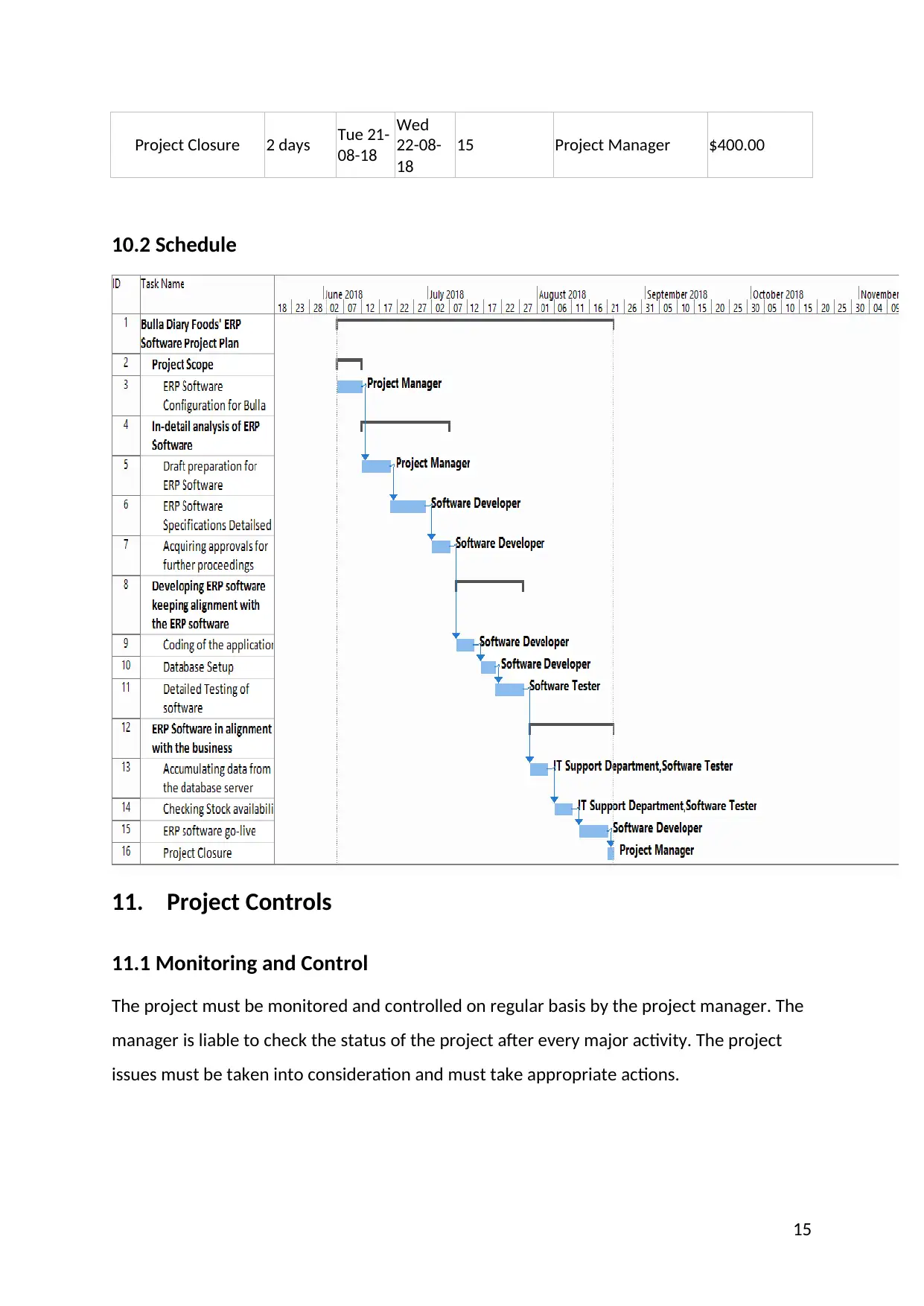
Project Closure 2 days Tue 21-
08-18
Wed
22-08-
18
15 Project Manager $400.00
10.2 Schedule
11. Project Controls
11.1 Monitoring and Control
The project must be monitored and controlled on regular basis by the project manager. The
manager is liable to check the status of the project after every major activity. The project
issues must be taken into consideration and must take appropriate actions.
15
08-18
Wed
22-08-
18
15 Project Manager $400.00
10.2 Schedule
11. Project Controls
11.1 Monitoring and Control
The project must be monitored and controlled on regular basis by the project manager. The
manager is liable to check the status of the project after every major activity. The project
issues must be taken into consideration and must take appropriate actions.
15
Secure Best Marks with AI Grader
Need help grading? Try our AI Grader for instant feedback on your assignments.
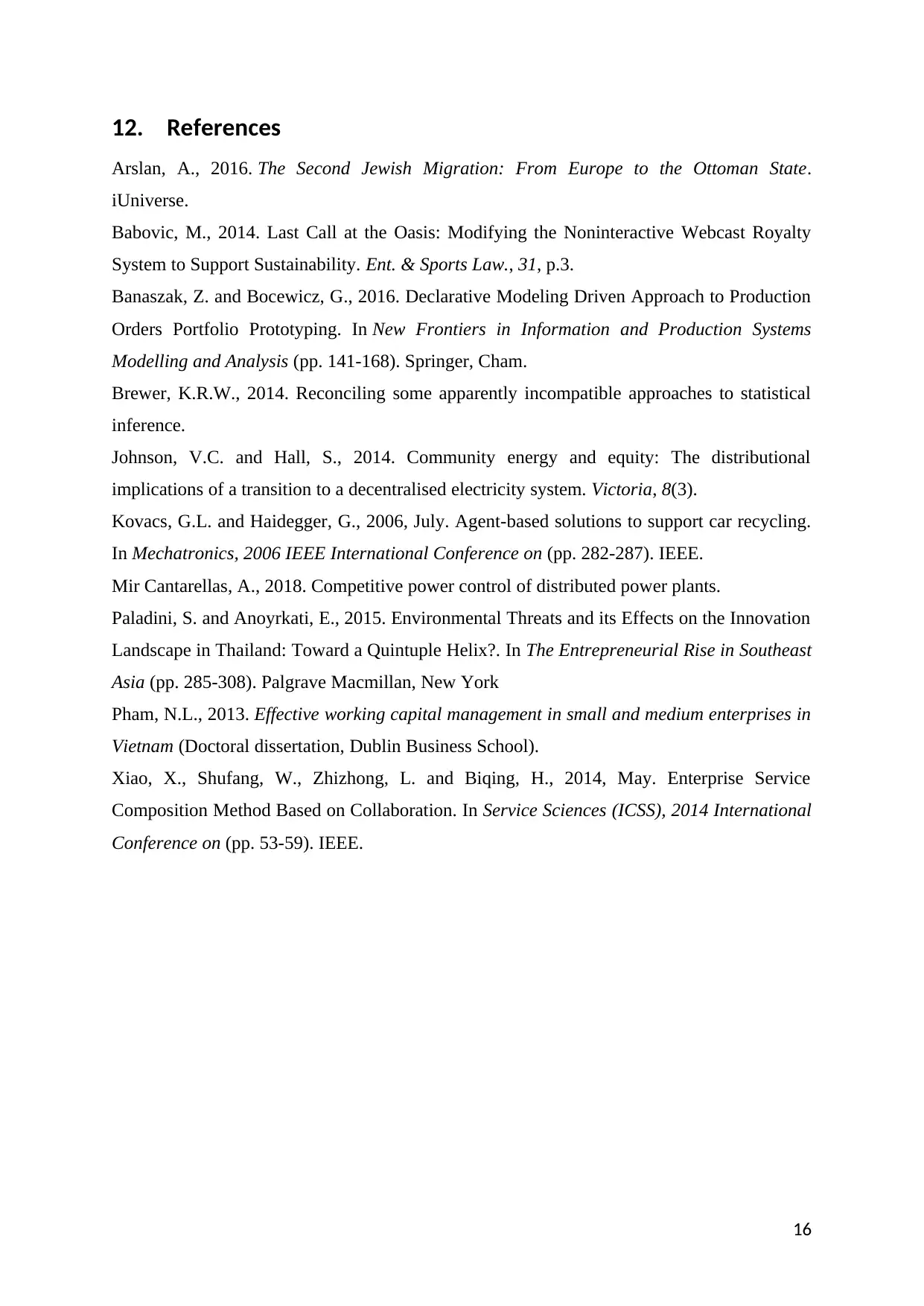
12. References
Arslan, A., 2016. The Second Jewish Migration: From Europe to the Ottoman State.
iUniverse.
Babovic, M., 2014. Last Call at the Oasis: Modifying the Noninteractive Webcast Royalty
System to Support Sustainability. Ent. & Sports Law., 31, p.3.
Banaszak, Z. and Bocewicz, G., 2016. Declarative Modeling Driven Approach to Production
Orders Portfolio Prototyping. In New Frontiers in Information and Production Systems
Modelling and Analysis (pp. 141-168). Springer, Cham.
Brewer, K.R.W., 2014. Reconciling some apparently incompatible approaches to statistical
inference.
Johnson, V.C. and Hall, S., 2014. Community energy and equity: The distributional
implications of a transition to a decentralised electricity system. Victoria, 8(3).
Kovacs, G.L. and Haidegger, G., 2006, July. Agent-based solutions to support car recycling.
In Mechatronics, 2006 IEEE International Conference on (pp. 282-287). IEEE.
Mir Cantarellas, A., 2018. Competitive power control of distributed power plants.
Paladini, S. and Anoyrkati, E., 2015. Environmental Threats and its Effects on the Innovation
Landscape in Thailand: Toward a Quintuple Helix?. In The Entrepreneurial Rise in Southeast
Asia (pp. 285-308). Palgrave Macmillan, New York
Pham, N.L., 2013. Effective working capital management in small and medium enterprises in
Vietnam (Doctoral dissertation, Dublin Business School).
Xiao, X., Shufang, W., Zhizhong, L. and Biqing, H., 2014, May. Enterprise Service
Composition Method Based on Collaboration. In Service Sciences (ICSS), 2014 International
Conference on (pp. 53-59). IEEE.
16
Arslan, A., 2016. The Second Jewish Migration: From Europe to the Ottoman State.
iUniverse.
Babovic, M., 2014. Last Call at the Oasis: Modifying the Noninteractive Webcast Royalty
System to Support Sustainability. Ent. & Sports Law., 31, p.3.
Banaszak, Z. and Bocewicz, G., 2016. Declarative Modeling Driven Approach to Production
Orders Portfolio Prototyping. In New Frontiers in Information and Production Systems
Modelling and Analysis (pp. 141-168). Springer, Cham.
Brewer, K.R.W., 2014. Reconciling some apparently incompatible approaches to statistical
inference.
Johnson, V.C. and Hall, S., 2014. Community energy and equity: The distributional
implications of a transition to a decentralised electricity system. Victoria, 8(3).
Kovacs, G.L. and Haidegger, G., 2006, July. Agent-based solutions to support car recycling.
In Mechatronics, 2006 IEEE International Conference on (pp. 282-287). IEEE.
Mir Cantarellas, A., 2018. Competitive power control of distributed power plants.
Paladini, S. and Anoyrkati, E., 2015. Environmental Threats and its Effects on the Innovation
Landscape in Thailand: Toward a Quintuple Helix?. In The Entrepreneurial Rise in Southeast
Asia (pp. 285-308). Palgrave Macmillan, New York
Pham, N.L., 2013. Effective working capital management in small and medium enterprises in
Vietnam (Doctoral dissertation, Dublin Business School).
Xiao, X., Shufang, W., Zhizhong, L. and Biqing, H., 2014, May. Enterprise Service
Composition Method Based on Collaboration. In Service Sciences (ICSS), 2014 International
Conference on (pp. 53-59). IEEE.
16
1 out of 17
Related Documents
Your All-in-One AI-Powered Toolkit for Academic Success.
+13062052269
info@desklib.com
Available 24*7 on WhatsApp / Email
![[object Object]](/_next/static/media/star-bottom.7253800d.svg)
Unlock your academic potential
© 2024 | Zucol Services PVT LTD | All rights reserved.





